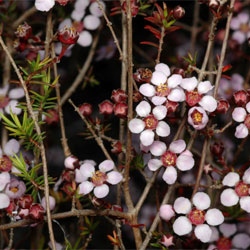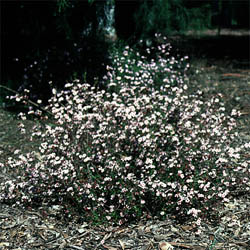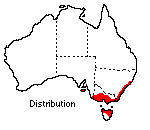Euryomyrtus ramosissima
 |
 |
Previously known as Baeckea ramosissima
Rosy Baeckea
Euryomyrtus ramosissima (A.Cunn.) Trudgen
This showy small shrub, commonly known as Rosy Heath Myrtle, belongs
to the Myrtaceae family. It is widely distributed from south-eastern New South
Wales through central Victoria to Tasmania and the Mt Lofty Ranges and on Kangaroo
Island in South Australia. Euryomyrtus ramosissima grows in a variety of
habitats ranging from sphagnum swamps, heaths or open forests on the coast to
mallee country inland. Throughout its range the species varies in habit from
low and procumbent to an erect shrub 1 m high and 1.5 m wide.
 There
are several different forms of B. ramosissima in cultivation: the prostrate
mountain form with small, white flowers; the compact form with deep, rosy pink
flowers; the upright form with pale pink flowers; and a prostrate form from
the south coast of New South Wales with small, white to pale pink flowers.
There
are several different forms of B. ramosissima in cultivation: the prostrate
mountain form with small, white flowers; the compact form with deep, rosy pink
flowers; the upright form with pale pink flowers; and a prostrate form from
the south coast of New South Wales with small, white to pale pink flowers.
The leaves are alternate, 4-10 mm long and 1-2 mm wide, and linear to cylindrical with scattered inconspicuous oil dots on the undersurface. The five-petalled flowers, 6-10 mm wide, are solitary in the axils of the upper leaves on slender pedicels which are longer than the leaves. The capsules have three compartments which usually each hold a pair of granular seeds.
Euryomyrtus ramosissima is a hardy shrub suitable for small gardens, rockeries and containers. It is relatively disease free and flowers profusely from spring to early summer. Tip pruning after flowering will induce bushiness and increase next season's flowering. It is frost-resistant and tolerates poor soils and extremely diverse growing conditions ranging from full sun to dappled shade and from continuously moist to intermittently dry. Euryomyrtus ramosissima may be propagated from semi-hardwood cuttings in summer, preferably from the lower shoots which have not yet flowered. Alternatively, the species may be grown from seed but this is often difficult to collect.
Text by Andrew Hughes, ANBG (1986)
Name meaning: Baeckea ramosissimaBaeckea - in honour of Abraham Baeck (1713-1795), Swedish physician and naturalist, a friend of Linnaeus; ramosissima - from the Latin, ramosus, branched, and the suffix -issimus, most, referring to the much-branched habit of the plant. |
![An Australian Government Initiative [logo]](/images/austgovt_brown_90px.gif)

